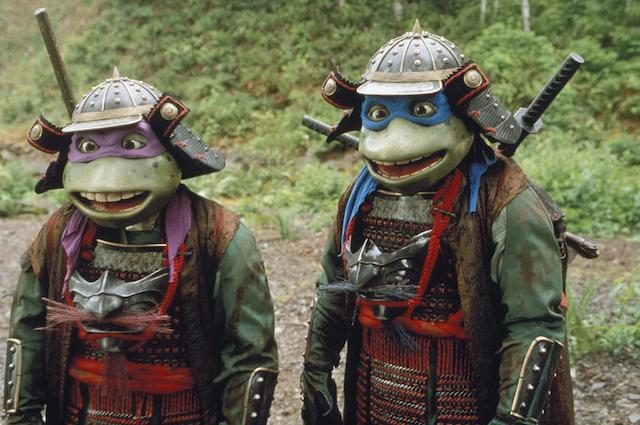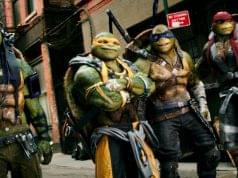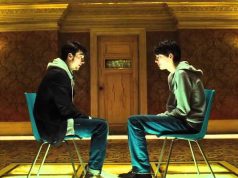
Within the category of adolescent reptilian comic book characters who are horrifying freaks of nature and skilled in ancient fighting arts, the Teenage Mutant Ninja Turtles are by far the most important, with an impact on pop culture much greater than, for example, the Pubescent Two-Headed Bullfrog Samurai, or the Cyclops Freshmen Salamanders Who Know Some Karate. Yet even the TMNTs, as respected as they are, have suffered indignities in the process of being adapted for TV, movies, lunchboxes, tattoos, folk songs, and religious texts. Among these misfires is the source of today’s discussion: “Teenage Mutant Ninja Turtles III.”
I must confess up front that I’m at a disadvantage here. It was a very long time ago that I saw the first “Teenage Mutant Ninja Turtles” movie, and I never saw the second one, “Teenage Mutant Ninja Turtles II: The Secret of the Ooze,” due to my longstanding policy of avoiding anything with the words “teenage” and “ooze” both in the title. It’s possible that these factors prevented me from truly connecting with the final chapter in the trilogy, whose nuances escaped me.
Whatever happened in Part 2, it apparently had a devastating effect on the turtles, and in particular on their ability to not look like they are wearing rented Halloween costumes. Splinter, the giant rat who is their trainer, father figure, and pet rat, has likewise suffered a tragedy, one that only allows him to be seen if he is standing behind a waist-high wall — as if he were nothing more than a cheap puppet!
In any event, part 3 begins with one of the turtles feeling melancholy over having to live hidden away in an abandoned subway station. The turtle in question is either Michelangelo, Leonardo, Donatello, or Raphael. I don’t know which one. They all look identical, and any differences that once existed in their personalities or behavior have long since faded, and so the only way to tell them apart is by the color of bandana they wear. I briefly considered memorizing which color goes with which turtle before it dawned on me that to accept this as one of my professional obligations would be to admit that I have chosen the wrong profession.
It doesn’t matter anyway, as soon enough they’re all in 17th century Japan. This is because their human friend April (Paige Turco) stops by their lair with a dusty old relic she picked up at an antiques store, and this relic turns out to be a magical Japanese scepter that will cause whoever is holding it to switch places with whoever is holding it in 1603 in Japan. This doesn’t happen EVERY time you pick up the scepter, though, only when it’s convenient for the story. So suddenly April has vanished, and in her place is a confused young man from feudal Japan named Kenshin (Henry Hayashi). The turtles, drawing on their intricate knowledge of insane plot devices, determine that they’ll have to go to ancient Japan and rescue April, which means bringing four ancient Japanese guys to the present to take their places. This switching-places business is necessary to maintain the balance of the cosmos or something, but it’s terribly unjust. Imagine how those poor Japanese dudes feel, just minding their own business when suddenly they’re dragged to 1993 just because some turtles wanted to go sightseeing.
The movie is very serious about maintaining this balance. The two people swapping places must weigh the same, and only their bodies are transported, not their clothes. The movie is quite strict on this point. Kenshin materializes not only in the spot where April was just standing, but also in her clothes, and April arrives in feudal Japan wearing Kenshin’s robes, with nothing else having been transported with her through the portals of time and space, nothing at all, except for her Walkman. What? Yes, her Walkman seems to have made the journey with her. The movie therefore amends its rules to say that only flesh and blood AND portable music-playing devices can travel through time, nothing else, not even clothes. Well, OK, maybe if you’re a warrior you can bring your sword with you, as the four Japanese guys do. But THAT’S IT! Nothing else!
Oh, and the turtles only have 60 hours to get April and come back, because after 60 hours the portal will close forever, because whoever wrote the movie read a book once that said screenplays are more exciting if they have deadlines.
It should be a pretty easy task, but of course it isn’t. Nothing is ever easy when you’re dealing with magic time-travel scepters and their arbitrary, loosely enforced rules! For one thing, as soon as the turtles arrive in feudal Japan, one of them gets separated from the group. Let’s say it’s Michelangelo. So now they have to find Michelangelo (or whoever), AND find April, AND find the scepter. They also have to help the local villagers fight a rebellion against their oppressive overlord. Eventually, anyway. First they have to hang around for a long time, befriending village children and bleating out dumb one-liners in those irritating surfer-dude voices of theirs. “Hey, dudes, check it out!” says a turtle, possibly Botticelli. “We’re in ‘Shogun’!” He is referring to the 1980 TV miniseries, with which the “Teenage Mutant Ninja Turtles III” audience is undoubtedly familiar.
At first the locals think the turtles are demons, an assessment that is not only fair but possibly even accurate. Then one of the turtles (Modigliani) rescues a kid from a burning house and saves his life by giving him CPR (and probably salmonella), and so now it doesn’t matter if the turtles are demons, because they are also heroes! This kind of stuff goes on for a while, and the turtles do precious little of their signature fighting. You get the impression that when the filmmakers learned they had to make the entire movie on a budget of seventy-five dollars, fight choreographers were the second expense they did away with, after costumes.
When it’s finally time to take April and return to the present, wouldn’t you know it, they can’t find the scepter. Not a problem, says the turtle named Caravaggio. He’ll just make another scepter! He goes ahead and does this, and nobody tells him it’s stupid to think that a scepter he made in shop class will have the same powers as the magic scepter. We have no choice but to assume that April, the other turtles, and the villagers all think it will work too, i.e., that they are just as dumb as the turtle who thought of it. I became genuinely curious to see if it WOULD work, as this would mean that the filmmakers were as dumb as the characters, and from what I’d seen so far there was a good chance of that. Alas, the homemade scepter falls into a well before it can be used — and then it turns out some moron villager had the real scepter all along anyway, making that whole sidetrack a complete waste of time.
Speaking of which, if you ever want to feel weary of your existence, contemplate what it means for something to be a waste of time in a movie that is already “Teenage Mutant Ninja Turtles III.” Even by the breathtakingly low standards of mindless movies aimed at undiscerning children, this one is a chore to watch. They really should have gone with the other comic book franchise, Underage Aberrant Kung Fu Iguanas.
— Film.com





